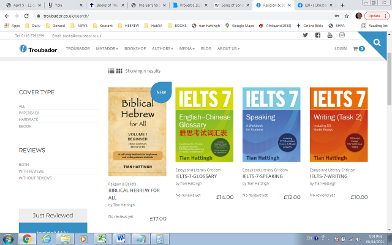

________________________
On-line Classes
Content
1. Student Levels / Objectives
1.1 Beginners
1.2 Elementary
1.3 Intermediate
1.4 Textual criticism
1.5 Text discussions
2. Methodology
2.1 Class Schedules
2.2 Class Sizes
2.3 Class Structure
2.4 Study Buddies
3. Fees
3.1 Class Fees
4. Curricula
4.1 Beginners
5. Useful links
5.1 Troubador Publishing Group
5.2 Biblehub
5.3 YouTube


1. Student Levels / Objectives
1.1 Beginners
( Volume 1 )
1.1.1 Target Population
All over the world there are people from all walks of life that love to read the Tanakh / Hebrew Bible / Christian Old Testament. Many of them have always been fascinated by biblical Hebrew and have wondered what it would be like to be able to read the Hebrew Bible in the language that it was originally written in.
They would like to spend some time studying the language but for a number of reasons have never embarked on such an adventure. There might be several reasons for this:
a) Some believe that the language can be mastered only by those with superior intellectual abilities. This is definitely a false assumption. I, for one, am evidently of a bit below the average intelligence level, but I have not encountered a single concept in the needed grammar that I could not with a bit of effort eventually internalize for myself. (Sure, I have read many publications dealing with highly technical issues, where I had little or no idea of what the author is trying to say).
b) They do not have the opportunity to get involved in a formal academic program at a tertiary institution, and have no interest in obtaining a formal academic qualification in this field. I believe that this series will provide a viable opportunity to many of them.
c) They want to be able to study at their own pace, and do not want to be placed under the pressure of having to meet assignment deadlines and/or to pass a formal examination.
d) They cannot / do not want to spend vast amounts of money on class fees and textbooks in their quest to master the language.
e) They do not want to get involved in highly technical aspects of the language. They simply want to be able to read and understand as much as possible of the original text of the Hebrew Bible.
If you consider yourself to be one of the above-mentioned people, be rest assured that I am exactly such a person as well, and that it was with someone like you in mind that I wrote Volume 1.
All the volumes are self-study textbooks. This means that you could get very far without the help of a tutor. The objective of the on-line classes are to assist you in solving problems instantly, instead of spending hours looking for the answer by yourself.
With a hard copy or PDF file of Volume 1 in hand, you do not have to purchase any other books. At this stage you do not even have to buy a dictionary. The word lists found in Volume 1 contain sufficient material, and additional materials are available free of charge on websites like Biblehub.com. Hebrew Bibles are available free of charge at a number of websites.
Hard copy and PDF formats both have their advantages. A hard copy enables one to make additional notes exactly where needed, and physically look at more than one page at a time. On the other hand, a PDF file is much less expensive, more durable and more portable. Visit our store here.
1.1.2 Objectives
After you have worked through Volume 1 you will be able to read and understand a vast amount of text in the Hebrew Bible. This is particularly true of the books that contain historic narratives. Included in Volume 1 are almost all the basic grammar structures you will need, as well as all the nouns, the regular "strong verbs," as well as elements like numbers, pronouns, and prepositions. In Biblical Hebrew the so-called "Strong Verbs" are the most frequently encountered, and fortunately the most simple to master. However, there are many other verb classes that are more intricate and irregular. They are dealt with fully in Volumes 2 & 3. You will therefore not be able to fully understand sentences that contain these irregular verbs. However, in many instances the context of the sentence will help you to get a pretty good idea of what the text is saying. For example, you will be able to read Genesis 1:1 completely although it does contain what is a so-called a "weak verb" ending in an aleph.
_______________________
1.2 Elementary
( Volume 2 )
1.1.1 Target Population
Students who have worked through and to some extent mastered the material presented in Volume 1.
_______________________
1.3 Intermediate (Volume 3)
1.1.1 Target Population
Students who have worked through and mastered the material presented in Volume 2.
_______________________
1.4 Textual criticism (Volume 4)
1.1.1 Target Population
Chapters 66-71
would be interesting and informative to anyone who would like to learn more about the history of the process how the Hebrew Bible eventually came to be as we know it today.
Chapters 72-75
deals with the concept of Textual Criticism. Anyone who is intending to study the Hebrew Bible should take note of these chapters. From this the need for any serious student to engage in some form of textual criticism will become clear. In addition the basic principles involved in this process will become clear.
Chapters 76-78
deal with essential tools that are needed when one actually becomes involved in such a process.
Chapter 79
deals with the practical implementation of all the above. By dealing with 1,548 footnotes from BHS as examples, students will become totally capable of reading and understanding BHS footnotes.
_______________________
1.5 Text discussions (Volume 5)
1.1.1 Target Population
In this volume we present 400 texts from the Hebrew Bible. This includes:
1. The Masoretic Text.
2. A literal translation.
3. Five modern English translations.
4. Notes on what is tually acfound in the text.
5. Notes on how it came about that the modern English translations fell short in:
a) Showing all the aspects and nuances involved in the text.
b) In many cases coming to a partly or totally incorrect conclusion of what the
original text actually means.
Anyone would be able to read the notes, but without mastering the material in Volumes 1-4 of this series, there would be a lot of material that a person would not be able to comprehend.

2. Methodology
2.1 Class Schedules
2.1.1 Times
I am currently employed as an ESL teacher in Vietnam. It is common in our industry for teachers to have only 20-30 hours of actual class time per week. This means that I have substantial hours available for teaching online. These times are spread over all the days of the week. This, together with the fact that my students are situated in different time zones, makes it possible for me to present classes at almost any time that suits them.
2.1.2 Class Frequency
Past experience has shown that in order to keep your enthusiasm and focus strong, and to discuss and solve any possible problems, you need to meet a tutor at least once a week for at least an hour.
2.1.3 Course Duration
This will depend entirely on how much time you are able to spend working with the language. In the past I have found that, excluding class time, students spend from 2-5 hours per week. Students get a kick out of something as simple as being able to recite the Hebrew alphabet after a week or two.
Generally speaking, and with the above in mind, you should be able to, on average, work through one chapter per week to complete Chapters 1-21. Chapters 1 & 2 will take more time. Chapters 10, 17, and 18 involve a lot, but others like Chapters 3, 6, 9, and 19 are substantially shorter. In other words, about 6 months. Chapters 22-29 usually takes another 24 weeks to master for a total of about one year.
2.1.4 Becoming discouraged
An age old pedagogic principle that I strongly believe in, and has been well proven in my previous classes, is Practice makes perfect. We practice when learning to play a musical instrument, but when studying a language I like to change that and say, Review makes perfect. Consecutive lessons in Volume 1 are accumulative as well. In other words, when starting a new lesson we are building on what we already know, and are constantly referring back to and reviewing previous lessons.
One of my toughest tasks as a tutor is to motivate discouraged students. I am forever stressing the fact that Review makes perfect. Please do not become discouraged when you encounter a section that seems to be too much for you. Remember that we are building a foundation here, and we will encounter that concept over and over again as we build on it. Be rest assured that at some point even those difficult sections will become one of your skills, and from then on you will be able to effortlessly implement it into future texts when and where needed.
2.2 Class Sizes
2.2.1 One-on-One
It is clear that one-on-one classes have distinct advantages:
a) The student enjoys the undivided attention of the tutor for the full duration of the class.
b) The tutor is able to adjust his teaching style and speed to perfectly fit the level and specific needs of the student.
The major disadvantage of one-on-one classes is that it is the most costly teaching option.
2.2.2 Group Classes
Conversely, group classes have the following disadvantages:
a) Individual students are not able to enjoy the undivided attention of the teacher.
b) The teacher has to focus on the needs of the average student. Above-average students will find the class boring, while slower students will not be able to keep up with the rest of the class.
The advantages of a group class include the positive effect of group dynamics, and the reduction of the costs for any one individual student.
2.3 Class Structure
2.3.1 Lesson plan
The following lesson plan will be used for one-one-one as well as group classes:
1. Review.
The students will, by means of a summary by the tutor, be reminded of what was dealt with in the previous lesson. If needed, the students will be given the opportunity to ask questions on any outstanding issues that they might have.
2. Presentation of new material.
Note: In preparation for a class, the students will have gone through the new material as it was agreed on in the previous class. Here the teacher will work through the material with the students and add additional comments and/or explanations where and when needed.
3. Feedback.
By asking them questions, the teacher will receive feedback from the students and so identify any possible problem areas in the newly acquired material.
4. Planning.
The teacher and students will plan the activities for the forthcoming week. They will decide which new work has to be covered, and decide if any assignments and/or exercises that will have to be completed before the next lesson.
2.4 Study Buddies
2.4.1 Pairs
My former students have proven that speaking to one's peers often leads to new insights into the material. In addition, it seems to have a dramatic effect on improving motivational levels.
In the case of one-on-one tutoring, I will try and bring two students that are on approximately the same level into contact with one another. Such pairs will then be able to confer with each other at times convenient to them both.
2.4.2 Study Groups
I have also found that group classes often organize themselves into pairs and/or into smaller study groups that meet and have informal discussions wherever and whenever they find it convenient.

3. Fees
3.1 Class fees
Depending on the number of hours a student engages in per week, and because of the great effect that exchange rates have in different countries, class fees are negotiated with students individually.
USA students typically pay US$ 12.00 per hour for 2 hours/wk.
4. Curricula
4.1 Beginners (Volume 1)
4.1.1 Introduction
1. Introduce myself.
2. Overview of the course.
3. Student introduction. Expectations.
4.1.2 Internet Tools
Refer to section 5 below.
1. Biblehub.com
2. YouTube
3. The Sar Shalom Bible
4.1.3 Chapters 1 - 21
1. General grammar principles.
4.1.3 Chapters 22 - 29
1. The Strong Verbs.
4.2 Elementary (Volume 2)
4.2.1
This section is currently being written.
4.3 Intermediate (Volume 3)
4.3.1
This section is currently being written.
4.4 Textual criticism (Volume 4)
4.4.1
This section is currently being written.
4.5 Text discussions (Volume 5)
4.5.1
This section is currently being written.

5. Useful links
5.1 Ingram Spark
All the volumes in the Biblical Hebrew for All series are available from the Ingram Spark Bookshop. Hard copies of the books in the series can be purchased and be shipped all over the world by clicking HERE.
Currently, textbooks containing vast amounts of Hebrew cannot be published in an ebook format.
5.2 Biblehub https://biblehub.com/interlinear/
This website contains a treasure trove of information and study tools pertaining to the Old testament as well as the New Testament for free. For example:
1. Interlinear Bibles in Hebrew and Greek.
2. No less than 29 commentaries.
3. No less than 22 English versions.
4. A comprehensive concordance, including the information found in the Brown - Driver - Briggs
Hebrew and English Lexicon.
Click here to enter the dashboard of biblehub.com.
5.3 YouTube
1. Animated Hebrew https://www.youtube.com/user/animatedhebrew
This series of 279 short videos (35 hours in total), presented by Mr. Charles Grebe is a must watch for any student. It is based on the 40 chapters in the book Introducing Biblical Hebrew by Allen P. Ross.
Click here for a dashboard with a list of links to the YouTube channel.
Mr. Grebe has a personal website with many interesting and useful sections.
Click here to have a look around.

_______________________
Contact me
email: christiaan.hattingh777@gmail.com
facebook: Christiaan Hattingh
________________________